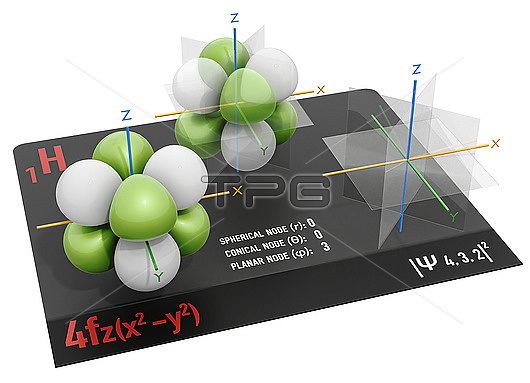
4fz(x2-y2) electron orbital, illustration. An electron orbital is a region around an atomic nucleus (not seen) in which one or a pair of electrons is most likely to exist. The 4fz(x2-y2) orbital is made up of eight lobes. The orbital is seen transparent at middle to show the axes of symmetry and the planar nodes can be seen at right. Nodes are the regions in an atom with zero electron density and where the electron is least likely to exist. For the 4fz(x2-y2) electron orbital, 4 indicates that it is the fourth energy level, f indicates that the orbital is specifically an f-orbital, and z(x2-y2) indicates a complex orientation in the x-, y-, and z-planes. The f-orbitals are more complex in shape compared to s-, p-, and d-orbitals, and they have a total of seven possible orientations. The 4fz(x2-y2) orbital can accommodate up to 2 electrons. The 4f orbitals are part of the 4 shell, which also contains one spherical 4s orbital, three bi-lobed 4p orbitals, and five daisy-shaped 4d orbitals (except z2) all at a lower energy level (not seen).
| px | px | dpi | = | cm | x | cm | = | MB |
Details
Creative#:
TOP29775970
Source:
達志影像
Authorization Type:
RM
Release Information:
須由TPG 完整授權
Model Release:
N/A
Property Release:
N/A
Right to Privacy:
No
Same folder images:

 Loading
Loading